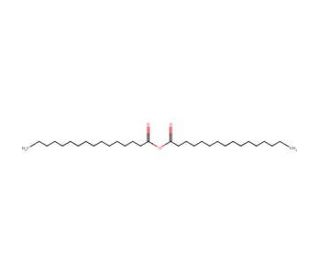

Palmitic anhydride (CAS 623-65-4)
QUICK LINKS
Palmitic anhydride, derived from palmitic acid, is a useful reagent in research focused on organic synthesis and materials science. As an acylating agent, it introduces palmitoyl groups to various substrates such as alcohols, phenols, and amines, forming esters and amides. This property is particularly advantageous in modifying natural and synthetic polymers, where palmitic anhydride is employed to enhance hydrophobicity, improve thermal stability, and optimize mechanical properties. For instance, it is used to functionalize cellulose and starch, resulting in biodegradable films and coatings that exhibit improved water resistance. This modification is beneficial in packaging, agriculture, and environmental research. Moreover, palmitic anhydride plays a crucial role in surfactant and detergent synthesis, offering insight into the development of surface-active agents that can emulsify and stabilize complex mixtures. In lipid chemistry, it facilitates studies on esterification processes, providing researchers with a model system to investigate catalyst efficiency, reaction kinetics, and product distribution. In surface science, palmitic anhydride helps modify substrates by acylating surface hydroxyl groups, thereby achieving specific adhesion, wettability, and surface energy characteristics. Its use extends to advanced composite formulations, anti-corrosion coatings, and lubrication studies. Overall, this versatile compound aids in understanding key mechanisms in polymer science, surface chemistry, and organic synthesis.
Palmitic anhydride (CAS 623-65-4) References
- Novel polymer micelles prepared from chitosan grafted hydrophobic palmitoyl groups for drug delivery. | Jiang, GB., et al. 2006. Mol Pharm. 3: 152-60. PMID: 16579644
- Discovery of fatty acid ester metabolites of spirolide toxins in mussels from Norway using liquid chromatography/tandem mass spectrometry. | Aasen, JA., et al. 2006. Rapid Commun Mass Spectrom. 20: 1531-7. PMID: 16628595
- A reinvestigation of the synthesis of arsonolipids (2,3-diacyloxypropylarsonic acids). | Tsivgoulis, GM. and Ioannou, PV. 2008. Chem Phys Lipids. 152: 113-21. PMID: 18313402
- Biologically active ether lipids. Biotransformation of rac-1(3)-O-alkylglycerols in cell suspension cultures of rape and semisynthesis of 1-O-alkyl-2-palmitoyl-sn-glycero-3-phospho-(N-palmitoyl)ethanolamines, potent antitumor agents. | Apte, SS., et al. 1990. FEBS Lett. 265: 104-6. PMID: 2365047
- Assessment of acylation routes and structural characterisation by liquid chromatography/tandem mass spectrometry of semi-synthetic acyl ester analogues of lipophilic marine toxins. | de la Iglesia, P., et al. 2014. Rapid Commun Mass Spectrom. 28: 2605-16. PMID: 25366407
- Lipase-catalyzed synthesis of palmitanilide: Kinetic model and antimicrobial activity study. | Liu, KM. and Liu, KJ. 2016. Enzyme Microb Technol. 82: 82-88. PMID: 26672452
- Synthesis of Sucrose Fatty Acid Esters by Using Mixed Carboxylic-fatty Anhydrides. | Trabelsi, I., et al. 2020. J Oleo Sci. 69: 693-701. PMID: 32612019
- Enhanced Enzymatic Synthesis of Puerarin Palmitate with Different Acyl Donors for Lipid Solubility Improvement. | Lee, S., et al. 2024. Int J Mol Sci. 25: PMID: 38255784
- Purification and characterization of an N-acylphosphatidylserine from Rhodopseudomonas sphaeroides. | Donohue, TJ., et al. 1982. Biochemistry. 21: 2765-73. PMID: 6980013
- Synthesis of 1-palmitoyl-2-hexadecyl-sn-glycero-3-phosphocholine (PHPC). | Duclos, RI. 1993. Chem Phys Lipids. 66: 161-70. PMID: 8111932
Ordering Information
| Product Name | Catalog # | UNIT | Price | Qty | FAVORITES | |
Palmitic anhydride, 1 g | sc-215665 | 1 g | $41.00 | |||
| US: (Out of Stock: Availability November 7, 2025) | ||||||
